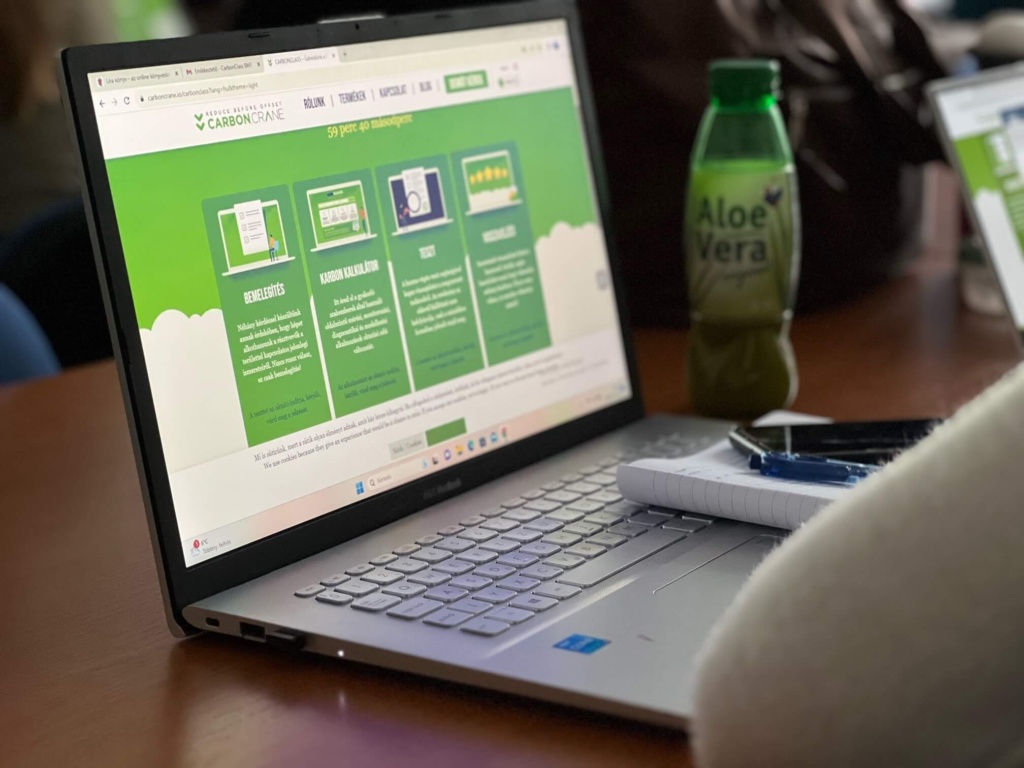In the fall semester, Dorottya Vincze was one of the first students to participate in a session of our university education program, CarbonClass. As an Environmental Engineering student, her commitment to sustainability was a given, yet our workshop opened up a whole new perspective for her. How does she use what she learned from us now? We discussed this and much more in a short interview with her.
Last November, we launched our new workshop specially designed for university students at the Budapest University of Technology and Economics (BUTE or, as known in Hungary, BME). When we developed these sessions, in addition to sharing theoretical knowledge and practical experience, it was important for us that participants could try the measurement, monitoring, and modeling tools we use. We also offer a badge as a certificate of the knowledge acquired, which many of our students proudly display on their LinkedIn profiles. Dorottya Vincze has done so, but CarbonClass has given her much more: she has decided to incorporate the learnings and the measurement solutions into her thesis.
Dorottya is a 23-year-old student of Environmental Engineering at the Budapest University of Technology and Economics. Prior to BUTE, she studied the same field at the University of Pannonia in Veszprém and also spent a semester in Vienna on a scholarship at BOKU (Universität für Bodenkultur Wien). I’m primarily interested in waste management, not from an industrial, but from an economic and individual consumer perspective, and how to act locally for a more sustainable future, she says. Like a dozen or so of her peers, she therefore chose the specialization in Environmental Management, combining the fields of engineering and business studies. Their group was the first to participate in a CarbonClass workshop as part of their thesis writing class and to try out Carbon.Crane’s digital carbon measurement and diagnostics tools.
I don’t recall that we have ever touched on the subject of the digital carbon footprint in our classrooms in Hungary, unfortunately, it just hasn’t been addressed. In Vienna, it was mentioned that the internet is also a major emitter, but only in passing, Dorottya recalls. Before the workshop, she hadn’t planned to include the carbon footprint of internet use and websites in her thesis, she had only focused on suppliers. But CarbonClass gave me a great new perspective, which I was very happy about. The whole system introduced a complex perspective. After the workshop, I looked at websites differently, and I immediately had a sense of how sustainable a site could be when I was looking at one, she adds.
Dorottya is writing her thesis on the long-term operations of packaging-free shops in the Budapest agglomeration. She is looking at different packaging-free shops, trying to understand what makes some of them successful and why, after a large opening wave, so many of them have closed. This can be influenced by a variety of factors ranging from location, year of opening, and external factors (Covid restrictions and economic environment) to extra services offered by the store, such as the existence of a webshop or extra workshops on the premises. This is also where the carbon footprint aspect came in. When I was looking for a calculator for my thesis, I realized that there are several available on the web, but they are not necessarily well known. Furthermore, as I am an Environmental Engineering major and not just studying management, the carbon footprint calculation is a concrete requirement, it is the engineering part of my thesis.
With the introduction of the digital carbon footprint aspect, I managed to find a very good example, the Lemérem shop in Újbuda, Dorottya says about her results so far. They were the only one of the shops surveyed with a site running on a server that uses sustainable energy. As I had a look at the website, I could see that it was very streamlined, and the measurement showed that it had an excellent result. (Note: We also measured their homepage with our Carbon Calculator, and the result was indeed impressive, only 0.05 g.) The others had YouTube videos embedded, and their pages were quite large. The Ligeti Bolt has been operating in Budapest for many years, they are considered pioneers, but unfortunately, they don’t have such good figures.
But how thought-out are these site developments? I don’t know yet how deliberate it was on their part — the interview part is still to come — but I plan to ask them, Dorottya promises at the end of the interview. In any case, we are looking forward to the results. We thank Dorottya for sharing her experiences and plans with us, and wish her all the best for her thesis! 😊









Comments are closed.